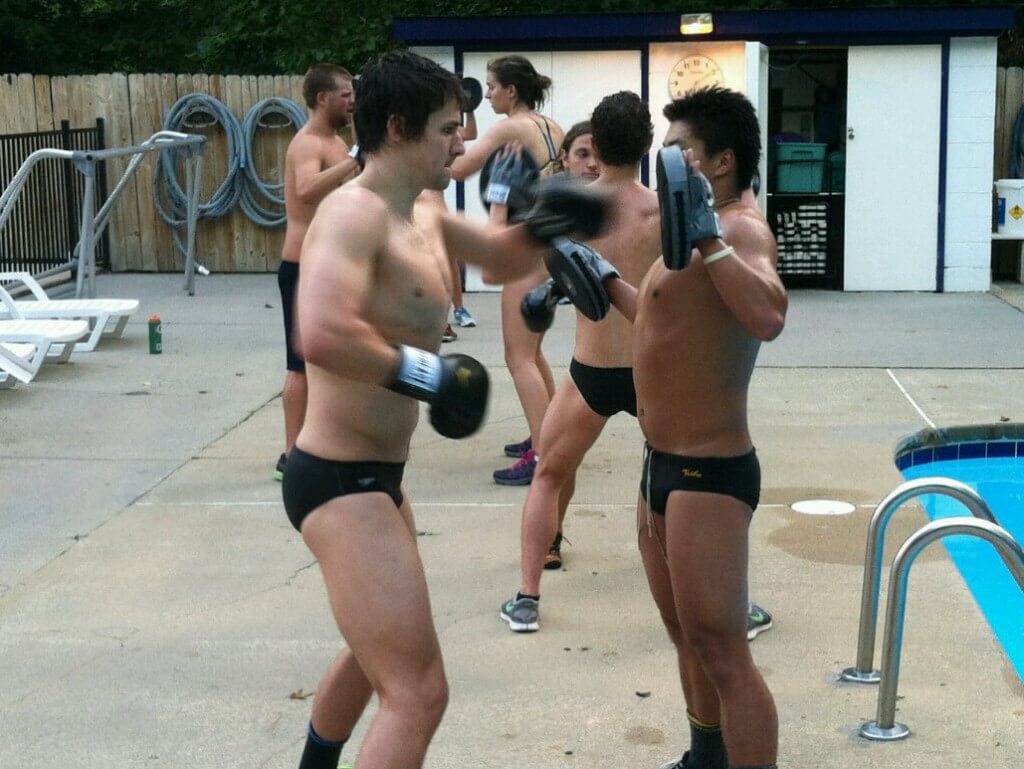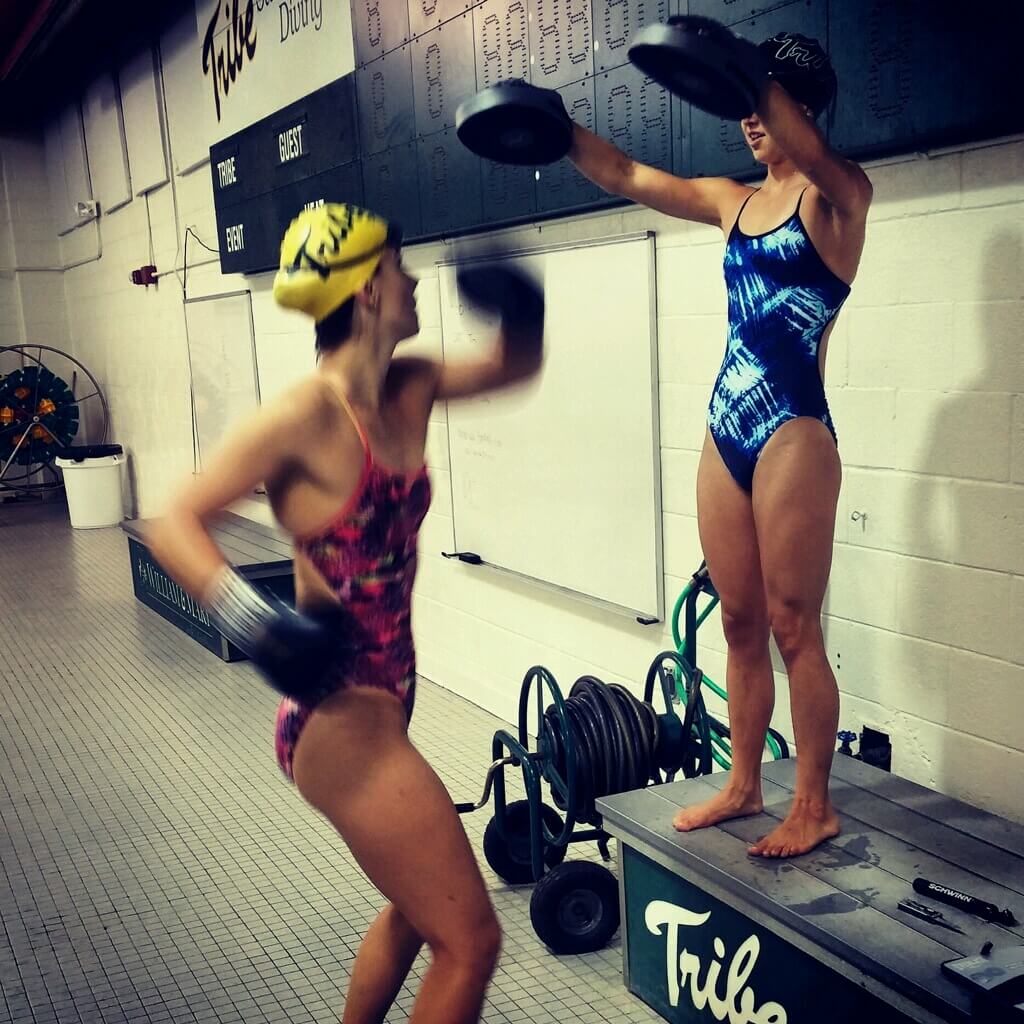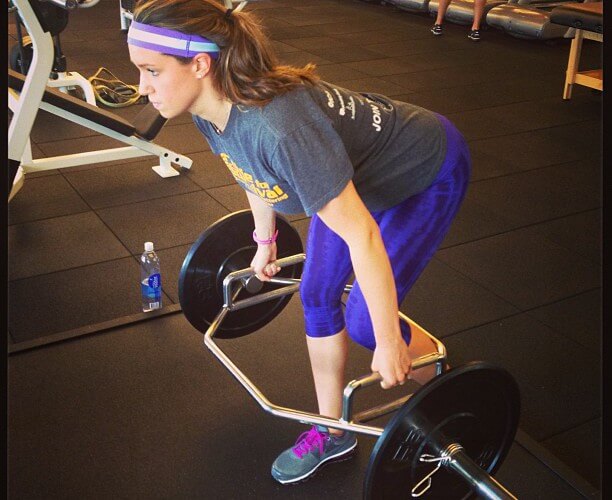Applicable Strength and Cross Training for Swimmers

By Will Manion, Swimming World College Intern
Swimmers can reap major benefits in the pool from strength and cross training on land. With so many options, it is important to evaluate the type of exercise you are doing out of the pool to ensure it will best benefit your stroke rate, pull, and kick. Personally, I enjoy boxing and lifting weights. I believe these two activities best prepare me to achieve my goals as a swimmer.
Let’s Get Ready to Rumble
William and Mary swimmers often utilizing boxing as a form of cross training. Sometimes, swimmers will gear up for and complete a series of uppercut and cross-over combos before stripping the boxing gloves and sprinting a 50 free all out. When I complete the boxing portion of this set, my shoulders are on fire and it becomes a matter of how well I can fight the fatigue and muscle strain in the following max effort swim.
Assistant William and Mary swim coach Josh Huger describes his philosophy.
“Boxing is a great way to develop upper body strength while also engaging the core. Different boxing drills can be altered to increase or decrease the intensity and difficulty of the workout.”
A Mental Break from the Pool
Cross training is a good time to step away from the countless hours swimmers engage following the black line at the bottom of a pool. Mixing up exercises provides a much-needed mental break, while still improving fitness. Huger details, “an additional benefit created by boxing is the enjoyment that it produces for the athletes. Adding variety into training keeps the athletes engaged while continuing to train at a very high level.”
Cross Training for Distance Swimmers and Sprinters
Cross training is beneficial when it is conducted in a safe manner under supervision from those educated on the exercise. Boxing is an activity that will benefit both sprinters and distance swimmers.
“In order to swim fast in any given distance, you need to develop power and speed,” Huger said. “Boxing can be utilized by athletes of varying levels of strength and fitness. Drills can easily be altered to increase or decrease the intensity and difficulty of the workout.”
Benefits of Weight Lifting for Swimmers
Josh Miller, William and Mary strength and conditioning coach, discusses what he does for Tribe Swimming:
“My job is to train these athletes to be physically prepared for the demands of their sport. Think of a pie, in my opinion, the slice that is missing out of a swimmer’s pie is strength and explosiveness. With the perquisite of proper movement patterns and exercise techniques already taught and mastered, I want the swimming athlete to be as strong and explosive as possible, regardless of their event. Through compound movements, my bias would be barbell training and Olympic lifting concepts. Training the swimming athlete to be strong and explosive through movements such as but not limited to; a squat (knee dominant human movement); RDL (hip-hinge human movement); and all upper body pulling movements are most beneficial. These correlate very well to those all so important starts and flip turns, which very commonly make or break a race.”
Weight Lifting As Injury Prevention
Miller designs his program to help keep swimmers healthy and prevent injury from overuse in the pool.
“Ask any swimmer, how do your shoulders feel at the highest yardage training point in the year? You’re likely to get a colorful description,” Miller said. “But to help keep those shoulders safe, I want you to visualize this. Think of how many times a swimmer’s shoulder internally rotates with each stroke. Now multiply that by week, then by month, then by semester…you get the picture. So by using different shoulder exercises (pulling, rowing and some pressing weight training) to counteract all of that internal rotation and anterior muscle dominance, I can help keep that swimmer’s shoulders in good posture and functioning as they should properly. This drastically reduces the risk of shoulder injury, which is music to their ears.”
Individualized Weight Training
Strength and cross training needs to be somewhat athlete specific. Ideal cross training methods will allow all athletes of different skill levels and ages to improve overall fitness and in turn, be better in the pool. An injured athlete can benefit from supplementary exercises provided they are under the supervision of a physical therapist or exercising a body part disassociated with injured area.
Cross training is utilized in various ways by swim teams around the world. It is important to keep it fun, but also ensure the workout is benefitting the athlete in the pool. In doing so, the athlete can prevent injuries while achieving that new personal record.






Jeannette
How to applay and where
Take a look Giovanna Duran Maselli
Tori Fountain
Samantha Wyllie
Samantha Wyllie
MaThieu Emmanuel ?
Dune efficacite a ttes epreuves.
Omar A. Elewa
Begad ana nefsy a-box.
Zane Rademaker
Angel Rafael Gugliotta Macias
Lewis Campbell we should start doing this
Lewis Campbell we should start doing this